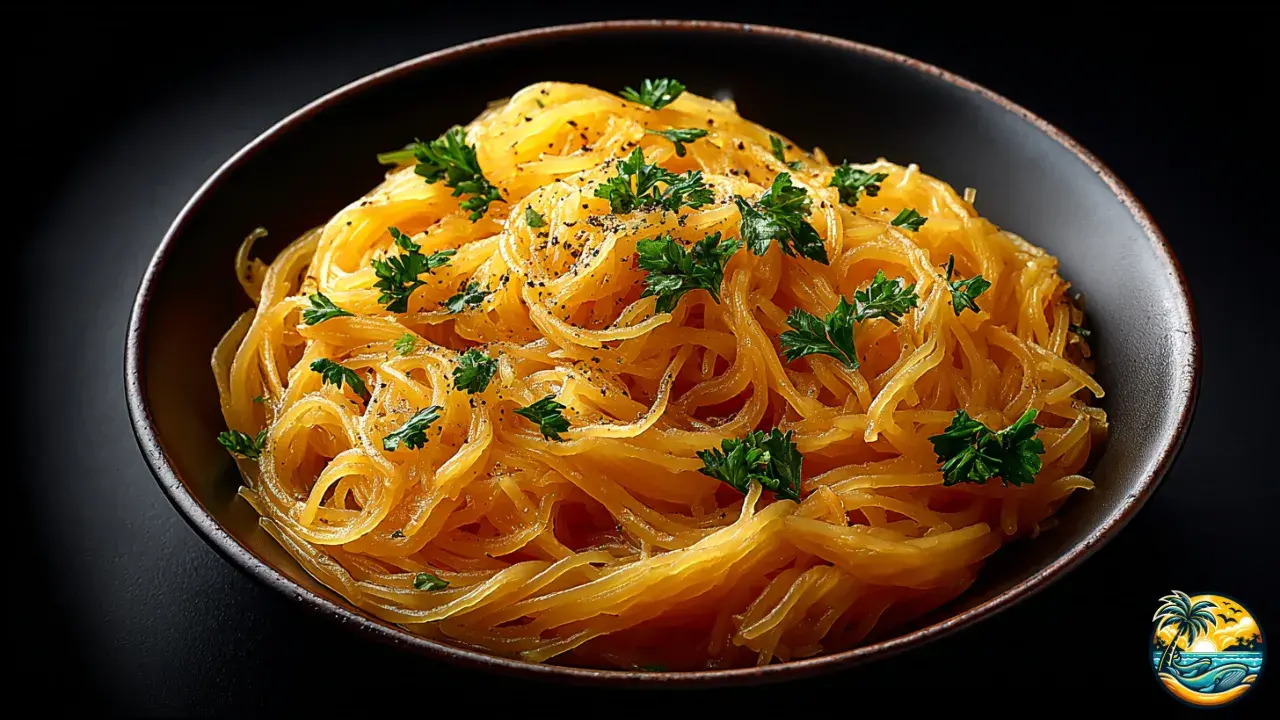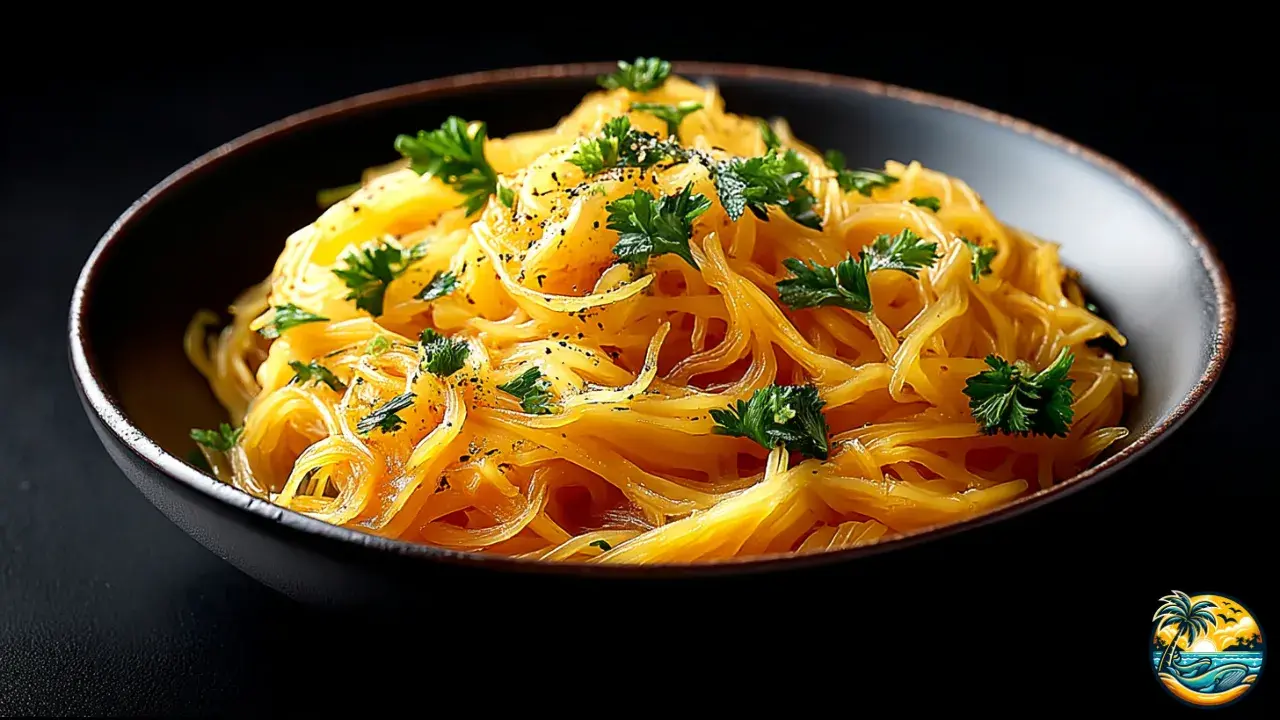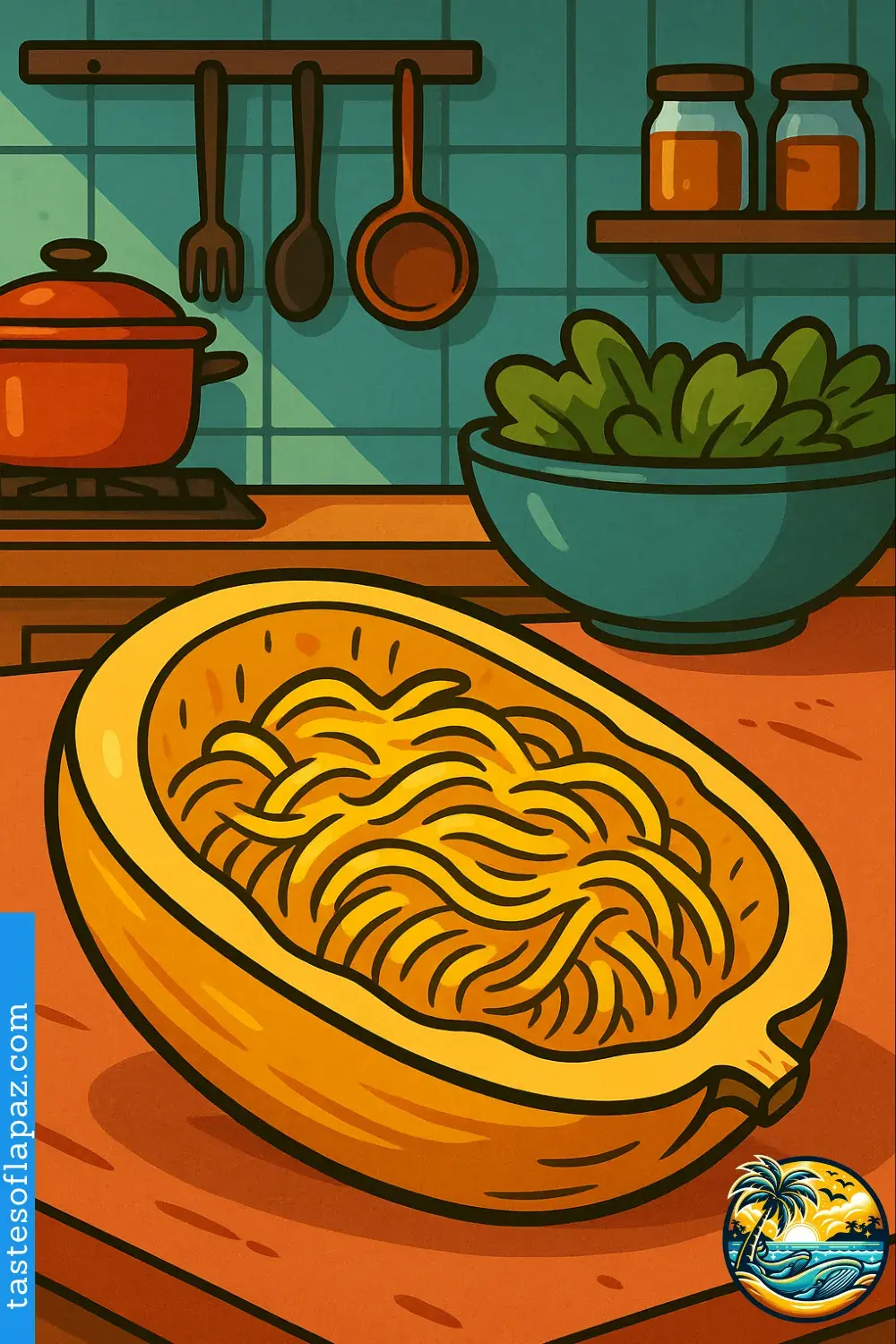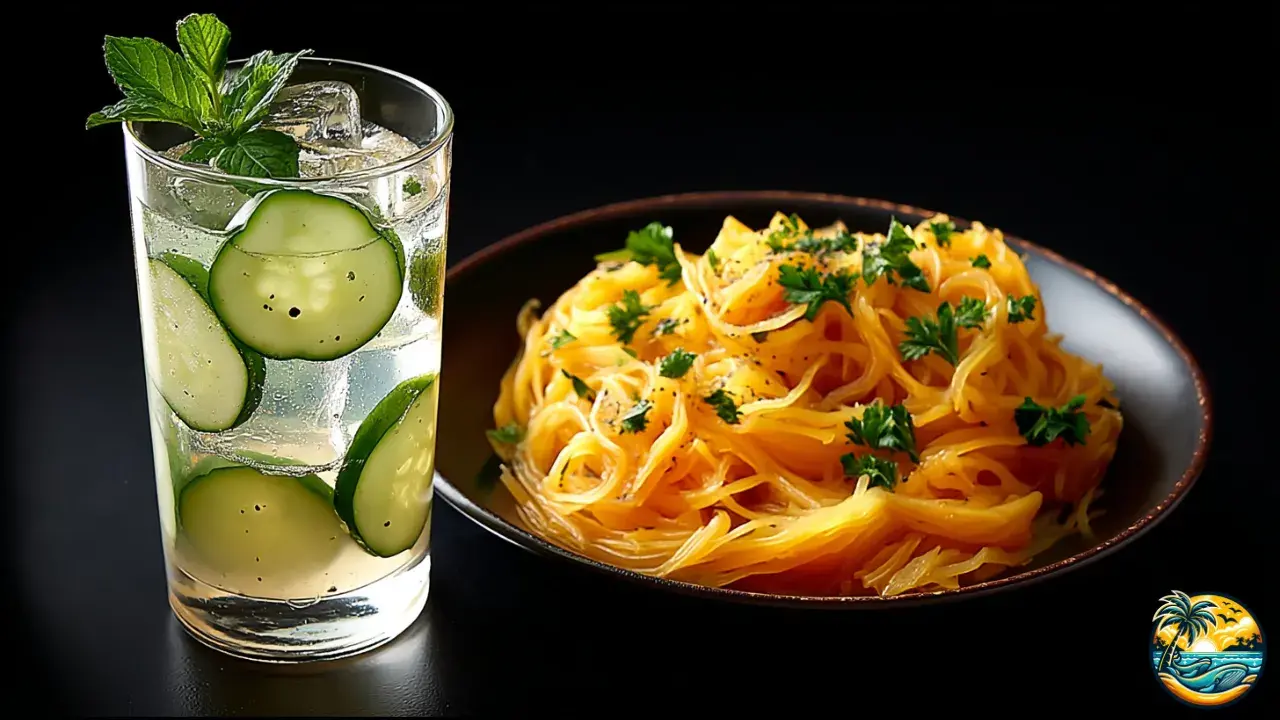Spaghetti Squash
Savor the World.
Spaghetti Squash
I’ve always been drawn to this healthy, easy, and low-carb option to use in nutritious meals—spaghetti squash. And to show you how simple it is, this recipe will teach you how to make a delicious and versatile dish that becomes a great alternative to traditional pasta, helping you eat better without sacrificing flavor.
Spaghetti Squash
Servings: 4
Prep Time: 10 minutes
Cook Time: 40 minutes
Total Time: 50 minutes
Ingredients
- 1 medium spaghetti squash (approx. 3 lbs / 1.4 kg)
- 2 tablespoons olive oil (30 ml)
- Salt to taste
- Black pepper to taste
- Optional: 1 teaspoon garlic powder (5 g)
- Optional: Freshly chopped green parsley
Equipment Needed
- Baking sheet
- Sharp knife
- Spoon
- Fork
- Oven
See 5 variations of the recipe at the end.
You might also be interested in:
Did You Know?
Did you know that spaghetti squash was not only delicious but also used in the 1800s as an inexpensive pasta substitute? Plus, its fibrous flesh can help reduce food waste by creating an easy and nutritious alternative to traditional pasta.
Instructions
- Preheat the oven: Let’s get started! Heat the oven to 400°F (200°C) to ensure perfect cooking and that your spaghetti squash turns out tender.
- Cut the squash: Now, carefully use a sharp knife to cut the spaghetti squash in half lengthwise. Remember, this squash has a tough skin, so take your time, go slow, and be safe.
- Remove the seeds: Okay, after cutting, use a spoon to scoop out all the seeds and fibrous pulp from the center. Trust me, this helps the squash strands come out clean and ready to use.
- Oil and season: Generously brush the inside of each half with olive oil. Then, season with salt and pepper to taste. If you like, sprinkle some garlic powder for an extra delicious touch.
- Place for baking: Let’s head to the oven! Place the halves cut side down on the baking sheet. You’ll see this helps the squash steam in its own juices, keeping the flesh moist and tender.
- Bake the squash: Cook for about 40 minutes. To check if it’s done, just insert a fork into the flesh; it should go in easily and the flesh should shred into spaghetti-like strands.
- Let it cool: Almost done! Take the halves out of the oven and let them rest for a few minutes so they cool enough for you to handle without burning yourself.
- Make the strands: It’s almost ready! Using a fork, gently scrape the flesh of the squash to form the classic spaghetti-like strands. Take it easy—you’ll see it’s simple.
- Serve: Done! Easy, right? Enjoy your spaghetti squash as a healthy, low-carb pasta substitute, top it with your favorite sauce, or add whatever you like!
Ingredient Substitutions
- Spaghetti squash: If you don’t have it, you can use butternut squash as an alternative, although the texture will be a bit different.
- Olive oil: You can substitute it with avocado oil or melted butter.
- Garlic powder: If you don’t like it, use some onion powder instead.
Preparation Tips
- Sharp knife: It’s always best to carefully use a well-sharpened knife to cut the squash easily and safely.
- Baking position: Place the halves skin-side up if you want a firmer texture or cut side down to soften faster.
- Resting: It’s important to let the squash rest a few minutes after baking to make handling easier and avoid burns.
- Extra touch: Oh, how delicious! You can sprinkle Parmesan cheese or fresh herbs when serving for added flavor.
- Toast the strands: Another great tip is to lightly toast the strands in a pan with a bit of oil for a stronger flavor.
Nutritional Information (per serving)
- Calories: 42 kcal
- Fat: 3 g
- Carbohydrates: 7 g
- Fiber: 2 g
- Protein: 1 g
- Sugars: 3 g
Nutritional Benefits
Spaghetti squash is an excellent source of dietary fiber, which helps improve digestion and keeps you feeling full. With its low calorie and carbohydrate content, it’s ideal for healthy diets and weight management without sacrificing flavor. Additionally, olive oil provides heart-healthy fats and aids in the absorption of fat-soluble vitamins. The optional garlic powder offers antioxidant and anti-inflammatory properties.
Storing & Reheating
- Storage: You can store leftovers in an airtight container in the fridge for up to 4 days without issues.
- Reheating: When heating the squash in the microwave or on the stove over medium heat, add a little oil or water to prevent drying out.
- Freezing: You can freeze it, but honestly, it’s best fresh to keep the texture. If you do freeze, be sure to use special bags and consume within 2 months.
Recipe History or Inspiration
Spaghetti squash is a traditional ingredient in American cooking that has gained popularity as a healthy and versatile option. Its name comes from the unique texture that, when cooked, breaks into strands resembling natural spaghetti, offering a gluten-free, low-carb alternative that appeals to those wanting to eat healthy without sacrificing flavor or texture.
Serving Suggestions
- Pair it with a fresh spinach salad with citrus vinaigrette.
- Grilled chicken with Provençal herbs is perfect!
- Crispy garlic bread complements the squash’s texture perfectly.
- Cucumber and mint infused water is a great drink choice.
- Enjoy a light lemon mousse for dessert to refresh your palate.
Frequently Asked Questions (FAQ)
- Can I cook spaghetti squash in the microwave? Yes, of course! You can cook it by poking holes in the skin and microwaving for 10-12 minutes, but keep in mind the oven always gives it a better texture.
- How do I know when the squash is ready? It’s easy—when you can easily insert a fork and the flesh shreds effortlessly.
- Can I eat the skin? Don’t do it; the skin of spaghetti squash is tough and fibrous, not recommended to eat.
- What if the squash is too big? Just adjust the cooking time—it might need a few extra minutes.
- Is it good for low-carb diets? Absolutely! It’s an excellent low-carb alternative to traditional pasta.
Recipe Variations
- Spaghetti Squash with marinara sauce: Delicious! Add your favorite tomato sauce and grated Parmesan cheese.
- Creamy version: Simply mix the squash with light cream and a bit of cream cheese for a richer dish.
- With sautéed vegetables: If you want more flavor, color, and health, add sautéed bell peppers, mushrooms, and zucchini for a colorful and nutritious meal.
- Pesto style: Oh, I love this one! Mix the strands with basil pesto and walnuts for a super fresh and aromatic flavor.
- Curry spaghetti squash: Just add curry spices and coconut milk for a more exotic twist.
So, this recipe is perfect as a healthy substitute for traditional pasta without sacrificing flavor, making it ideal for many people like you. Now that you know how to make it, you have a healthy, delicious, and super easy option to enjoy in your meals. Give it a try and discover just how versatile it can be. Happy cooking!
Tastes of La Paz.
Spaghetti Squash
Servings: 4
Prep Time: 10 minutes
Cook Time: 40 minutes
Total Time: 50 minutes
Ingredients
- 1 medium spaghetti squash (approx. 3 lbs / 1.4 kg)
- 2 tablespoons olive oil (30 ml)
- Salt to taste
- Black pepper to taste
- Optional: 1 teaspoon garlic powder (5 g)
Equipment Needed
- Baking sheet
- Sharp knife
- Spoon
- Fork
- Oven
Instructions
- Preheat the oven: Let’s get started! Heat the oven to 400°F (200°C) to ensure perfect cooking and that your spaghetti squash turns out tender.
- Cut the squash: Now, carefully use a sharp knife to cut the spaghetti squash in half lengthwise. Remember, this squash has a tough skin, so take your time, go slow, and be safe.
- Remove the seeds: Okay, after cutting, use a spoon to scoop out all the seeds and fibrous pulp from the center. Trust me, this helps the squash strands come out clean and ready to use.
- Oil and season: Generously brush the inside of each half with olive oil. Then, season with salt and pepper to taste. If you like, sprinkle some garlic powder for an extra delicious touch.
- Place for baking: Let’s head to the oven! Place the halves cut side down on the baking sheet. You’ll see this helps the squash steam in its own juices, keeping the flesh moist and tender.
- Bake the squash: Cook for about 40 minutes. To check if it’s done, just insert a fork into the flesh; it should go in easily and the flesh should shred into spaghetti-like strands.
- Let it cool: Almost done! Take the halves out of the oven and let them rest for a few minutes so they cool enough for you to handle without burning yourself.
- Make the strands: It’s almost ready! Using a fork, gently scrape the flesh of the squash to form the classic spaghetti-like strands. Take it easy—you’ll see it’s simple.
- Serve: Done! Easy, right? Enjoy your spaghetti squash as a healthy, low-carb pasta substitute, top it with your favorite sauce, or add whatever you like!
Nutritional Information (per serving)
- Calories: 42 kcal
- Fat: 3 g
- Carbohydrates: 7 g
- Fiber: 2 g
- Protein: 1 g
- Sugars: 3 g
Print this Recipe!

Tastes of La Paz.
















